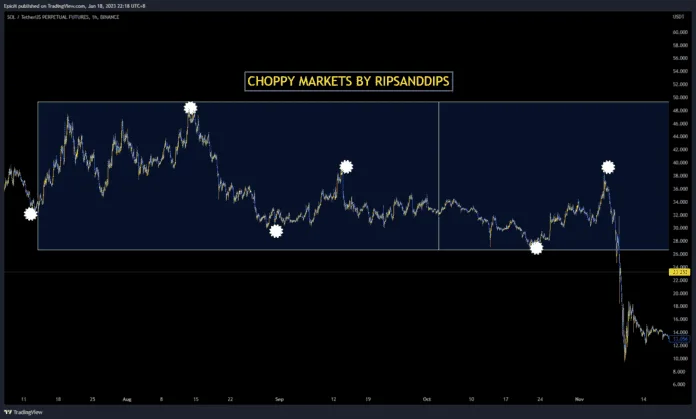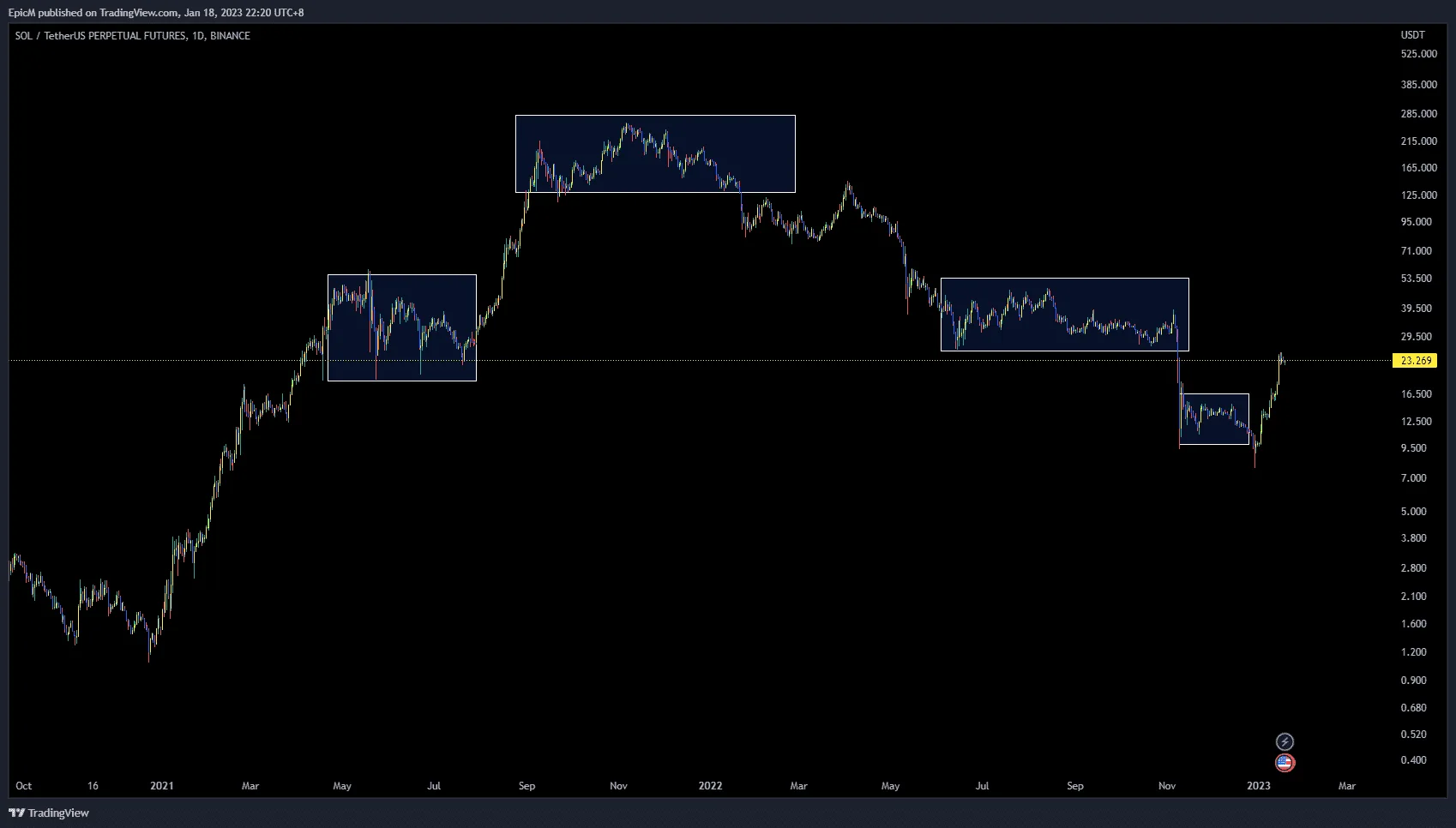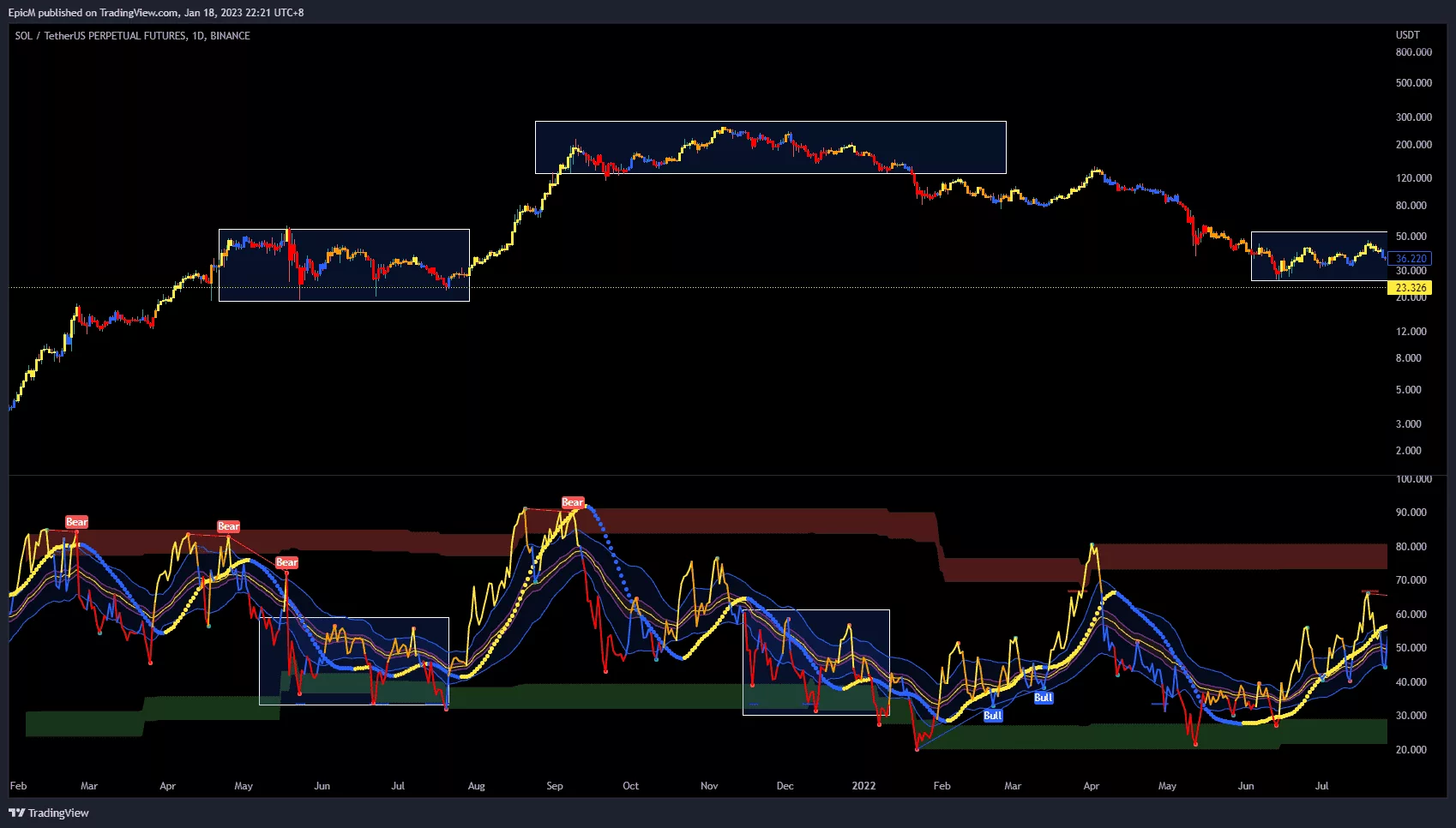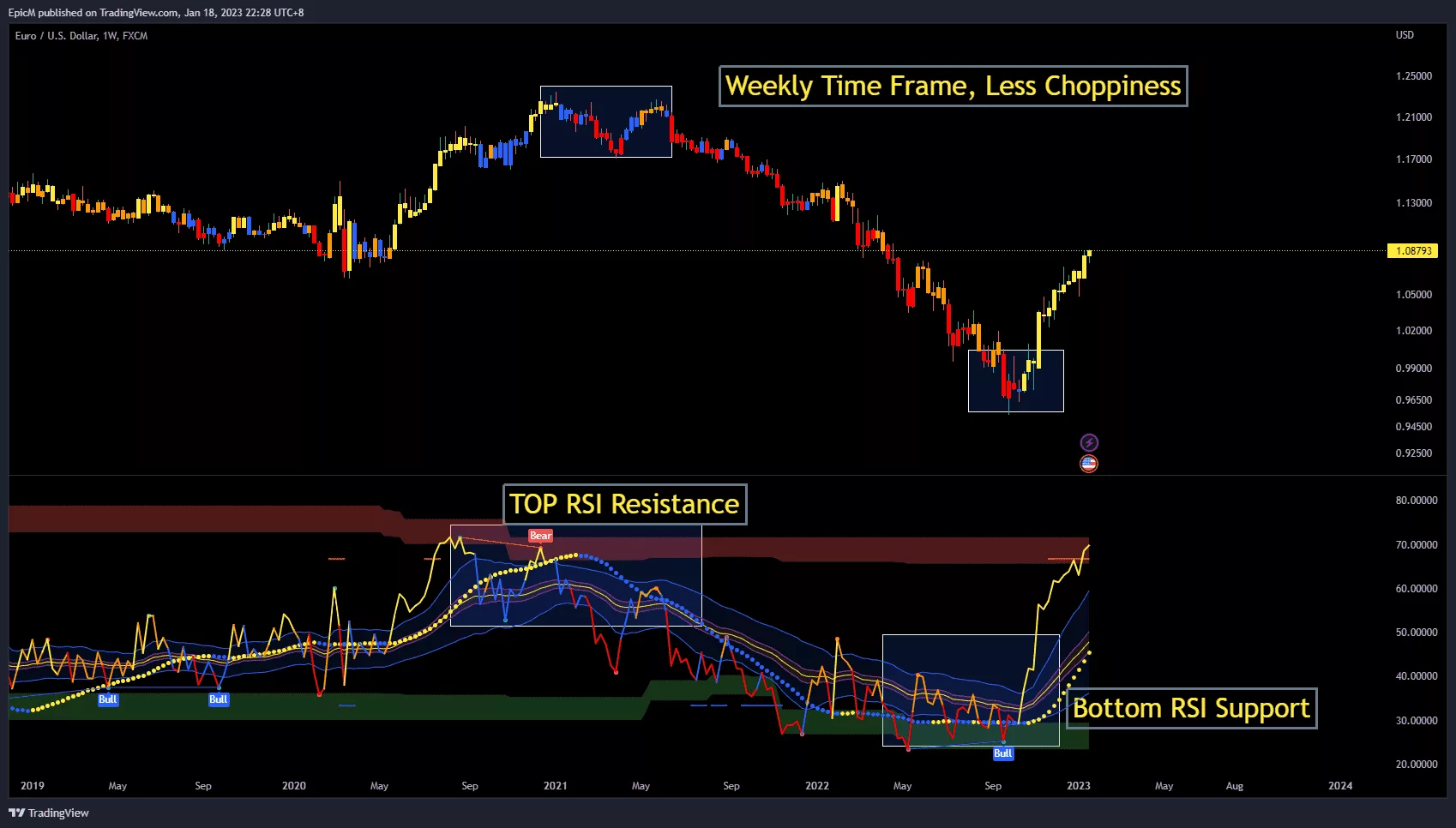Financial markets are frequently unpredictable, comparable to an erratic roller coaster. Successfully maneuvering through volatile market conditions can be exceptionally challenging. This comprehensive guide delivers the foundational knowledge and requisite tools for efficient trading amidst such uncertainty.
Whether you’re an experienced trader or just starting out, understanding how to read and act on market signals is essential for success in these conditions. This guide will explain the common characteristics of choppy markets, outline strategies for trading in these conditions, and equip you with the skills to make informed decisions when faced with a choppy market.
By following this guide and developing an understanding of how to trade in choppy markets, you’ll be able to confidently identify opportunities and maximize your profits, no matter what the market throws at you!
Indicators Used To Identify Choppy Markets In Forex Trading
For day trading in the forex market, understanding various indicators can be invaluable. Up to 90% of Forex traders make use of technical analysis and charting software when making investment decisions. By analyzing these indicators, investors gain valuable insight into the current state of the market.
Detecting choppy market conditions involves looking out for price action levels, support and resistance signals, relative strength index (RSI), and other tools like moving averages. Price action helps traders pinpoint when the market is swinging directions or merging. Support and resistance lines usually suggest if prices could reverse or carry on their trend. RSI helps identify range-bound or choppy markets as it reveals how “overbought” a currency pair might have become. Trading strategists may also employ several moving averages that signal short-term trends in combination with additional methods.
Keep in mind that these indicators cannot predict future price patterns systematically; however, they can decide whether entering a trade is a wise choice based on past performance data. Comprehending what induces ‘choppy’ circumstances on the Forex markets is critical information for day traders who want to expect breakout opportunities.
What Causes ‘Choppy’ Conditions In The Forex Markets?
Have you ever felt like the market is choppy and you’re not sure why? Chances are, you’ve experienced a choppy market condition. So what causes it?
A choppy market occurs when the price of an asset is indecisive and keeps moving sideways in a range-bound pattern. This makes it difficult to identify choppy markets and can frustrate for traders as they struggle to find profits in a volatile market. Here are some indicators of when the current market may be choppy:
• Volume: Low trading volume shows that investors lack confidence and aren’t willing to buy or sell shares, resulting in a choppy market.
• Range Bound Price Action: When price action oscillates between upper and lower boundaries with no clear direction or trend, I know this as range bound movement and can show there’s a choppy market.
• Moving Averages Crossover: When two moving averages of different lengths cross over each other within a range-bound channel, this could show that the market is currently choppy.
To summarize, identifying a choppy market requires carefully analyzing and observing price action and chart patterns to spot potential opportunities for profits in volatile markets.
Here are some examples comparing EURUSD with its Weekly Timeframe VS Daily Timeframe
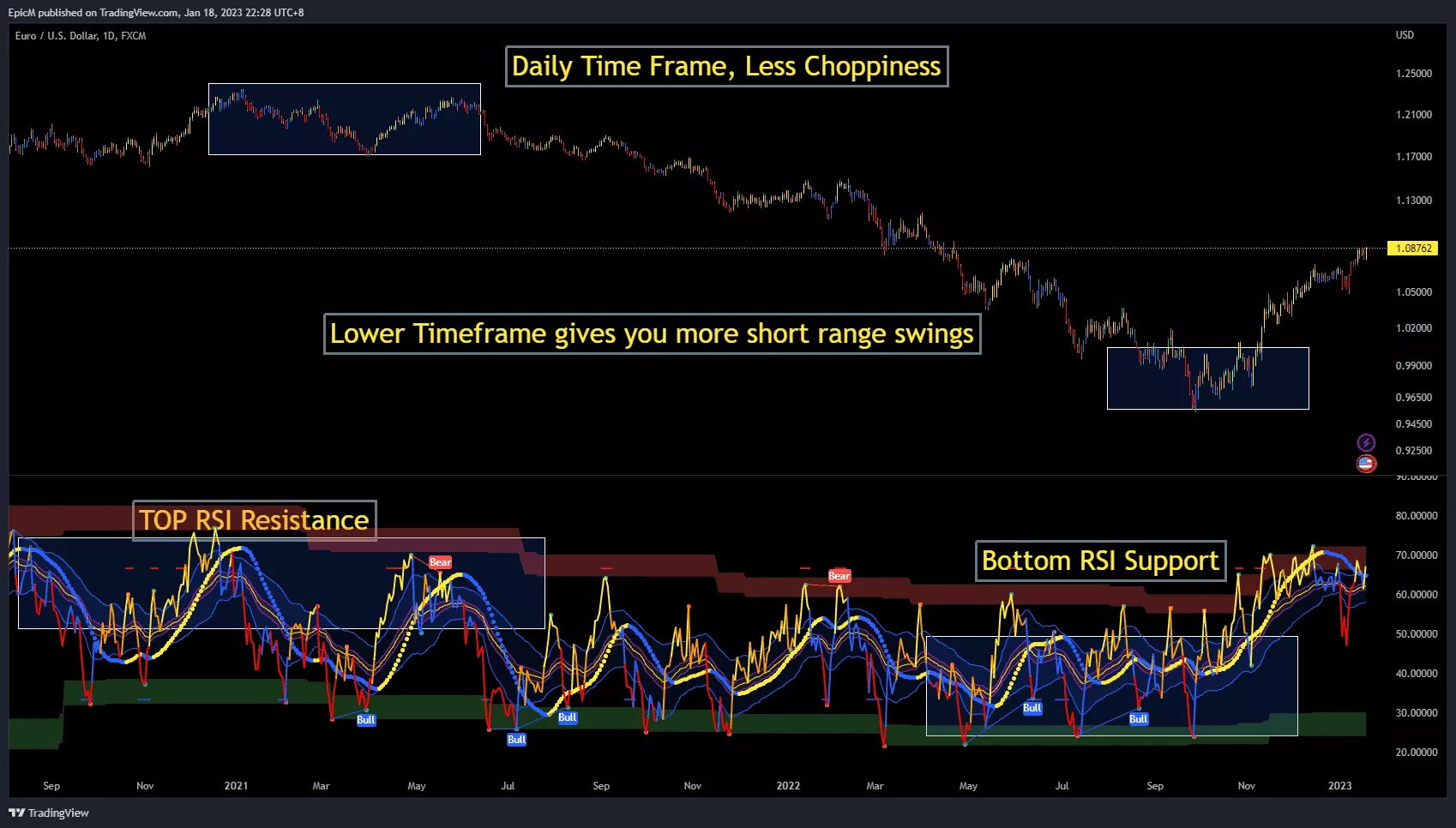
Analyzing Price Action & Chart Patterns To Find Profits In Volatile Markets
For identifying profitable opportunities in a volatile market, it’s essential to pay close attention to price action and chart patterns. Price movements can help reveal potential entry points for trading, while chart patterns can provide insight into the current state of the market.
Monitoring the Bollinger Bands–which display an asset’s high and low values over time–may help detect when a currency pair is “choppily” moving in no clear direction. Keep an eye out for any flat chart patterns on your charts as this could also signify choppiness, as buyers and sellers are looking for arbitrage opportunities. Being aware of support and resistance levels may come in handy when prices reach either side of the range during sideways trading; these levels act as guidance regarding where the market makers potentially intend to enter or exit the market because of shifting trends or uncertainty.
Every trade carries risk—so when trading in volatile markets, it is important to remain patient and exercise caution before deciding hastily. It will help you identify good trades if you actively monitor your charts throughout the day, as these can show you changes in price movements or chart patterns that point towards potential profits. With savvy strategic planning and well-thought out execution of trades, traders can make use of these ranges they observe while range trading to land successful trades even during tough market conditions.
The Best Time Frames For Your Money When Trading Choppiness
When trading choppiness, understanding the right time frames is crucial. Knowing when to enter and exit the market can be the difference between making a profit and getting stuck in ranging markets. As an investor, it’s important to identify short-term trends so you don’t trade when the markets are overbought or oversold.
Sometimes, this could mean staying out of the market for an extended period. But patience and discipline will often pay off. A tried and correct approach is to wait until price action signals an ideal strike price before entering a position. The key is to look for patterns that show momentum in order to determine what type of trade will work best in choppy markets.
TIP: To get the most out of your trades, try isolating one asset class or sector at a time. – this way you’ll be able to focus on smaller trends within larger ones and find profits more quickly. Now that you know how to assess time frames, let’s move on to applying options strategies during high volatility and low trends…

Depends On Your Strategy
Applying Options Strategies During High Volatility & Low Trends
Ah, options strategies. They can be the lifeblood of your portfolio when trading in choppy markets! From the Average Directional Index to trading ranges, these strategies can make all the difference between success and failure in times of high volatility.
Applying options strategies during high volatility and low trends requires a keen eye for details and an understanding of market dynamics. But don’t worry–with some research and practice, you’ll be able to take advantage of choppiness like a pro! Here are five key elements to consider when applying options strategies:
• Options Strategies: Consider using different options strategies, such as covered calls or debit spreads, to capitalize on choppiness.
• Options Trading: do your homework before entering any trade. Research the underlying security and use technical analysis tools like the Average Directional Index (ADX) to identify trends.
• Trading Range: monitor the trading range–if it’s too wide, it might show that the market is too choppy for you to risk entering any trades.
• Market Volatility: High volatility could mean that there’s more risk involved in your trades–make sure you’re comfortable taking on this risk before proceeding.
• Average Directional Index (ADX): The ADX is a great tool for gauging trend strength; if it’s below 25, then chances are that you’re dealing with a choppy market.
In short, having a solid grasp on options strategies can make all the difference in choppy markets. With careful planning and research, you’ll be able to navigate these markets like a pro!
Frequently Asked Questions
What Is The Most Effective Strategy For Trading Choppy Markets?
Approaching trading in a choppy market is an intimidating prospect for many traders, with only about 10% succeeding in consistent profits within this market. How can these short-term price twists, turns and unpredictable fluctuations be navigated? What is the most successful strategy to use when trading choppy markets?
First, traders must keep in mind that the best approach to trading sideways markets should mimic shape-shifting, as they gain a certain degree of positive returns if they invest without bindings and let the market go where it needs. Using two specific strategies should help you remain profitable and afloat amidst all the volatility. The first is the trend following; identifying a pattern or direction, then capitalizing on it until there are signs to reverse or change direction. It heightened the second risk-management; setting take profit and stop loss levels together with using orders such as limit and stop orders for minimizing losses and maximizing gains when prices move against them.
Traders must be prepared for periods of tight sideways action varying from small price movements to a few percents at most which require swift, accurate decision making relying on quickly read market trends with minimal average cost-per-trade as well range chart analysis here plays an important role by raising awareness of sudden spikes in range movements over pre-defined time frames where price action goes outside technical channel ranges.
How Can I Reduce The Risk Associated With Trading Choppy Markets?
Trading choppy markets can be an intimidating task, with the potential for huge losses. But by utilizing the correct trading strategies, you can reduce the risk associated with this type of market. To start, it’s important to have a method in place that will help you identify suitable market opportunities and make sound decisions about when to enter and exit trades. Technical analysis is a great tool for analyzing support and resistance levels on your chart. By studying these levels, you can gain insights which may show where the price might head next–allowing you to make informed trading decisions.
It’s important to keep in mind that no matter what technique you employ, there will always be some risk involved. That’s why it’s essential to implement risk management measures before making a single trade. Using stop-losses is an effective way to limit any losses should prex move against you unexpectedly. Having proper position sizing in place will help reduce your overall exposures during unpredictable moments on the market. It’s easy to get fearful when trading volatile markets, but setting up smart strategies as mentioned above can go a long way in helping minimize risks and enhance profitability!
What Is The Minimum Account Size Required To Trade Choppy Markets?
From novice traders to experienced investors, understanding the minimum account size required to trade choppy markets is essential for success. Risk management plays an integral role in a profitable trading strategy. The capital available determines market movement that can be taken advantage of, and can come at a substantial risk if not managed effectively.
The amount of capital you need depends on your risk appetite and experience level. A larger sum will ensure you have enough resources to weather turbulent dips in the market, while smaller accounts may restrict the type of positions suitable given the price action fluctuations. Different brokers will also stipulate their own requirements for setting up trading accounts, so read through their terms of service before committing funds.
It’s important to plan your trading with as much foresight as possible. Research potential moves higher or lower and uses indicators such as moving averages and momentum oscillators to help identify entries and exits based on market conditions. Generating options during periods when the share price stays static gives more limited profits compared to periods where the stock goes up or down dramatically.
Options offer greater protection from extreme price movements by allowing traders to take fewer positions and let go winners sooner than having no stop loss in place. Certain times such as 11 am to 2 pm–when markets usually go sideways – are ideal to reduce exposure due mainly because pricing behaviour for dividend stocks remains more predictable despite slight variations compared with equities, which can be more volatile during these hours.
What Criteria Should I Used To Determine When To Enter And Exit A Choppy Market?
Knowing when to open and close positions in a trending market is one of the most challenging tasks for any trader. To make the best decision, you must first locate a price area that has no clear direction or market action. It may be helpful to look for a rectangle, where the market shows no clear bull or bear trend and also looks like it will remain within given price ranges. Technical analysis tools such as moving averages and Fibonacci retirement levels can also help you identify potential entry and exit points in a choppy market.
When looking for ideal entry and exit moments, always consider the overall trend in the marketplace. Researching news and economic indicators could provide insight into how the direction of the market might shift, which can inform your decisions on when to enter or exit a choppy market. In addition, by studying where there are small moves in the opposite direction, you can assess whether now is an appropriate time to get long or short positions while still protecting your capital per trade.
Understanding what criteria should determine when to enter or exit a choppy market is indispensable if you want your trading journey to be successful. By considering various factors such as trends, indicators, and technical analysis tools, you can gain knowledge about potential moves in the marketplace and make knowledgeable decisions about when it’s best for entering or exiting these types of markets.
How Long Should I Expect To Remain In A Choppy Market?
In a choppy market, it’s important to understand how long you may be in there for. This can help when deciding what options to generate profits or losses through and when it might be best to move on. Despite being hard to predict, these markets usually see some level of volatility and price fluctuations throughout the duration of your stay.
The time in the choppy market may depend on the current news, how strategies are working out, and the help that market indicators can provide for identifying when the correct moment is to make a move. By understanding this timeframe it gives traders more control over their trades and reduces stress so they don’t worry about being stuck too long in chaotic markets.
Being prepared ahead of time can make trading decisions much easier than traders will already know what they may expect during uncertain times; this also applies when gauging supply & demand or an impending bull or bear trend in play. Preparation will include having enough strategies that work with one direction movement or using two different operations simultaneously. Both sides will have sufficient opportunities to reach trading success.
Conclusion
It’s daunting to trade choppy markets, but with the right strategy, you can make a profit. By having the proper account size and understanding when to enter and exit, you can reduce your risk significantly. With patience and dedication, you can use this comprehensive guide to navigate choppy markets like a pro.
In order to capitalize on trading opportunities in choppy markets, it’s important to have a simple plan of action. Knowing when to pick your spots is one of the most effective strategies for successful trading. By identifying the conditions that signal entry or exit points, you can make better decisions about when to invest your money.
Finally, remember that success in choppy markets takes time and patience – they did not build Rome in a day! If you stick with it, you’ll soon be able to reap the rewards of trading these tricky waters. With this comprehensive guide as your companion, you will find success trading choppy markets in no time!
